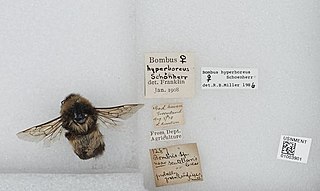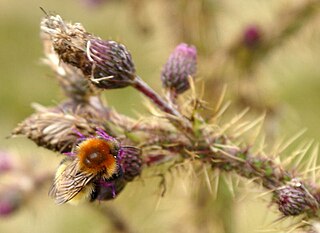
A bumblebee is any of over 250 species in the genus Bombus, part of Apidae, one of the bee families. This genus is the only extant group in the tribe Bombini, though a few extinct related genera are known from fossils. They are found primarily in higher altitudes or latitudes in the Northern Hemisphere, although they are also found in South America, where a few lowland tropical species have been identified. European bumblebees have also been introduced to New Zealand and Tasmania. Female bumblebees can sting repeatedly, but generally ignore humans and other animals.

Bombus terrestris, the buff-tailed bumblebee or large earth bumblebee, is one of the most numerous bumblebee species in Europe. It is one of the main species used in greenhouse pollination, and so can be found in many countries and areas where it is not native, such as Tasmania. Moreover, it is a eusocial insect with an overlap of generations, a division of labour, and cooperative brood care. The queen is monandrous which means she mates with only one male. B. terrestris workers learn flower colours and forage efficiently.

The early bumblebee or early-nesting bumblebee is a small bumblebee with a wide distribution in most of Europe and parts of Asia. It is very commonly found in the UK and emerges to begin its colony cycle as soon as February which is earlier than most other species, hence its common name. There is even some evidence that the early bumblebee may be able to go through two colony cycles in a year. Like other bumblebees, Bombus pratorum lives in colonies with queen and worker castes. Bombus pratorum queens use aggressive behavior rather than pheromones to maintain dominance over the workers.

Bombus hyperboreus is a species of Arctic bumblebee with a circumpolar distribution. The species is primarily found in the arctic areas of Greenland, northern Scandinavia, and Russia. In 2015 the nearctic species, Bombus natvigi, was separated from this species, based on genetic analysis. Accordingly, Bombus hyperboreus is limited to the Palaearctic, despite older literature listing this species as occurring in the Nearctic.

Bombus vestalis, the vestal cuckoo bumblebee, is a species of cuckoo bumblebee that lives in most of Europe, as well as North Africa and western Asia. It is a brood parasite that takes over the nests of other bee species. Its primary host is Bombus terrestris. After its initial classification as Psithyrus vestalis, this bumblebee recently was reclassified into the genus Bombus, subgenus Psithyrus.

Bombus citrinus is a species of bumblebee known commonly as the lemon cuckoo bumblebee due to its lemon-yellow color. It is native to eastern North America.

Bombus bohemicus, also known as the gypsy's cuckoo bumblebee, is a species of socially parasitic cuckoo bumblebee found in most of Europe with the exception of the southern Iberian Peninsula and Iceland. B. bohemicus practices inquilinism, or brood parasitism, of other bumblebee species. B. bohemicus is a generalist parasite, successfully invading several species from genus Bombus. The invading queen mimics the host nest's chemical signals, allowing her to assume a reproductively dominant role as well as manipulation of host worker fertility and behavior.

Bombus hortorum, the garden bumblebee or small garden bumblebee, is a species of bumblebee found in most of Europe north to 70°N, as well as parts of Asia and New Zealand. It is distinguished from most other bumblebees by its long tongue used for feeding on pollen in deep-flowered plants. Accordingly, this bumblebee mainly visits flowers with deep corollae, such as deadnettles, ground ivy, vetches, clovers, comfrey, foxglove, and thistles. They have a good visual memory, which aids them in navigating the territory close to their habitat and seeking out food sources.

Bombus pensylvanicus, the American bumblebee, is a threatened species of bumblebee native to North America. It occurs in eastern Canada, throughout much of the Eastern United States, and much of Mexico.

Bombus vosnesenskii, the yellow-faced bumblebee, is a species of bumblebee native to the west coast of North America, where it is distributed from British Columbia to Baja California. It is the most abundant species of bee in this range, and can be found in both urban and agricultural areas. Additionally, B. vosnesenskii is utilized as an important pollinator in commercial agriculture, especially for greenhouse tomatoes. Though the species is not currently experiencing population decline, urbanization has affected its nesting densities, and early emergence of the B. vosnesenskii has been implicated in the increasing lack of bee diversity on the West coast.

Bombus occidentalis, the western bumblebee, is one of around 30 bumblebee species present in the western United States and western Canada. A recent review of all of its close relatives worldwide appears to have confirmed its status as a separate species.

Bombus fervidus, the golden northern bumble bee or yellow bumblebee, is a species of bumblebee native to North America. It has a yellow-colored abdomen and thorax. Its range includes the North American continent, excluding much of the southern United States, Alaska, and the northern parts of Canada. It is common in cities and farmland, with populations concentrated in the Northeastern part of the United States. It is similar in color and range to its sibling species, Bombus californicus, though sometimes also confused with the American bumblebee or black and gold bumblebee. It has complex behavioral traits, which includes a coordinated nest defense to ward off predators. B. fervidus is an important pollinator, so recent population decline is a particular concern.

Bombus ruderatus, the large garden bumblebee or ruderal bumblebee, is a species of long-tongued bumblebee found in Europe and in some parts of northern Africa. This species is the largest bumblebee in Britain and it uses its long face and tongue to pollinate hard-to-reach tubed flowers. Bumblebees are key pollinators in many agricultural ecosystems, which has led to B. ruderatus and other bumblebees being commercially bred and introduced into non-native countries, specifically New Zealand and Chile. Since its introduction in Chile, B. ruderatus has spread into Argentina as well. Population numbers have been declining and it has been placed on the Biodiversity Action Plan to help counteract these declines.

Bombus muscorum, commonly known as the large carder bee or moss carder bee, is a species of bumblebee in the family Apidae. The species is found throughout Eurasia in fragmented populations, but is most commonly found in the British Isles. B. muscorum is a eusocial insect. The queen is monandrous, mating with only one male after leaving a mature nest to found its own. Males mate territorially and the species is susceptible to inbreeding and bottlenecks. The species builds its nests on or just under the ground in open grassland and forages very close to the nest. In recent years, populations have significantly declined due to loss of natural habitat. B. muscorum is currently listed as vulnerable in Europe by the European Red List of Bees.

Bombus affinis, commonly known as the rusty patched bumble bee, is a species of bumblebee endemic to North America. Its historical range in North America has been throughout the east and upper Midwest of the United States, north to Ontario, Canada, where it is considered a "species at risk", east to Quebec, south to Georgia, and west to the Dakotas. Its numbers have declined in 87% of its historical habitat range. On January 10, 2017, the United States Fish and Wildlife Service placed B. affinis on the list of endangered species, making the rusty patched bumblebee the first bee to be added to the list in the continental United States.

Bombus terricola, the yellow-banded bumblebee, is a species of bee in the genus Bombus. It is native to southern Canada and the east and midwest of the United States. It possesses complex behavioral traits, such as the ability to adapt to a queenless nest, choose which flower to visit, and regulate its temperature to fly during cold weather. It was at one time a common species, but has declined in numbers since the late 1990s, likely due to urban development and parasite infection. It is a good pollinator of wild flowers and crops such as alfalfa, potatoes, raspberries, and cranberries.
Apicystis bombi is a species of parasitic alveolates in the phylum Apicomplexa. It infects bees, especially bumblebees. It is believed to have a cosmopolitan distribution in bumblebees and a sporadic occurrence in honey bees, and causes disease symptoms in nonresistant bee species.

The half-black bumblebee is a small bumblebee with a wide distribution in North America, its range extending from Ontario to Nova Scotia and southward to Georgia.

Bombus griseocollis is a species of bumblebee known commonly as the brown-belted bumblebee. It is native to much of the United States except for the Southwest, and to the southernmost regions of several of the provinces of Canada.

Bombus sandersoni is a species of bumblebee known commonly as the Sanderson bumblebee. It is native to North America, where it occurs across Canada and in the eastern United States.



















